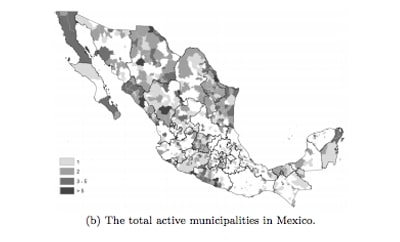According to a study which used Google searches to map the activity of drug cartels in Mexico, these criminal organizations are far from overrunning the whole country, being active in less than a third of the country’s municipalities.
El Universal highlighted a study by a team at Harvard University which developed a method that aims to track the activities of Mexican drug traffickers using information available on the Internet. The algorithm processes data produced by Google searches to extract information on where criminal groups operate.
The authors say that one of the main benefits of their method is that it could be a way to overcome the “inherent difficulty posed by the study of illegal actors: lack of data,” especially for countries with more limited resources. They noted that the information they found on gang operations would, if it was gathered by more conventional means, require large-scale intelligence exercises.
(Graph, right, shows the number of results per group, illustrating the sharp rise of Zetas activity from 2003 onwards.)
InSight Crime Analysis
One of the main findings of the study is that, in the period between 1991 and 2010, drug cartels were present in only 29 percent of the country’s 2,441 municipalities. The authors say that this allowed them to “challenge the widespread assumption that drug traffickers control vast regions of Mexico’s territory dividing the country in oligopolistic markets.” They note that the Sinaloa Cartel, for example, only appeared to be active in 14 of Sinaloa’s 18 municipalities in the period of study, while the Familia Michoacana was active in only 69 of Michoacan’s 115 municipalities.
This is an interesting way to quantify what is known about the Mexican drug trade. Unlike illegal armed groups in countries like Colombia, where the Revolutionary Armed Forces of Colombia (FARC) have controlled vast tracts of territory, setting up permanent camps and holding many prisoners, Mexico’s criminal groups are focused on controlling drug markets and transit routes. As the report notes, criminal activity is concentrated near Mexico’s large cities, the entry points to the United States, and highways connecting illicit crops or ports to the US border.
The reports also produces evidence showing the fracturing of criminal groups in Mexico. It found that the proportion of the municipalities affected by more than one criminal group was 62 percent in 2010, up from 11 percent a decade earlier.
Read InSight Crime’s report from a Google conference on using technology to fight drug gangs.

